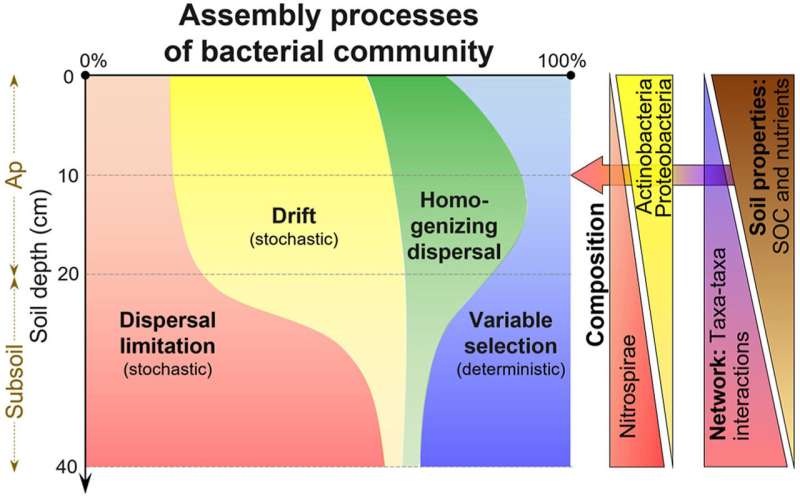Assemblages of bacterial communities depend on depths in paddy soils

Bacterial communities in soil play a key role in carbon (C) and nutrient cycling. It is not clear how geographic divergence in bacterial community composition depends on soil depth, which processes underlie community assembly, and which are the main factors.
In a study published in Soil Biology & Biochemistry, researchers from the Xishuangbanna Tropical Botanical Garden (XTBG) of the Chinese Academy of Sciences and the Institute of Soil Science evaluated bacterial community composition and mechanism of its assembly in soils of 26 rice fields in subtropics up to 40 cm depth.
The researchers found that nutrient contents strongly declined from topsoil to subsoil, in particular available phosphorus content. The bacterial diversity in the topsoil was also higher than that in the subsoil. The phyla Proteobacteria and Actinobacteria decreased with increasing soil depth, while the phyla Chloroflexi and Nitrospirae showed the opposite tendency.
Linkage density, average degree, edges, and average clustering coefficient increased with soil depth, indicating that the taxon-taxon co-occurrence network became more complex and associations were more connected.
Network analysis showed that the complexity of the bacterial community networks and the intensity of taxa-taxa interactions increased with soil depth. High modularity of bacterial network in the topsoil is associated with greater environmental perturbations to maintain the robustness of the microbial community composition.
The taxon-environment network analysis showed that soil texture and pH were more strongly correlated with bacterial taxa in the topsoil (0–20 cm), while soil nutrients were more important for the bacterial community in the subsoil.
In subtropical paddy soil, stochastic processes were predominant in bacterial community assembly up to 40 cm, and more stochastic at 10–20 cm. Drift dominated in topsoil, while dispersal was more restricted in subsoil.
"To our knowledge, this is the first study evaluating the networks and assemblages of bacterial communities depending on soil depths at a large geographical scale," said LI Weitao, first author of the study.
More information: Weitao Li et al, Depth effects on bacterial community assembly processes in paddy soils, Soil Biology and Biochemistry (2021). DOI: 10.1016/j.soilbio.2021.108517
Provided by Chinese Academy of Sciences





















